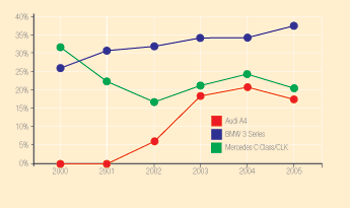The evolution of the 3-series is a perfect example of how the segment has evolved. This is not surprising as BMW has had the best product planning in the industry for most of the last 30 years within the confines of its own sector.
Originally a two-door saloon in the 1970s, then available as a four-door saloon in the early ’80s, a cabrio in the mid-’80s, an estate in the late ’80s and a coupe in the early ’90s. For most of its history, the saloon was the dominant body style, with the alternatives being profitable niches.
Now, however, the saloon is struggling to stay on pole.
Part of the problem is that, in such an image conscious segment, saloons are becoming the motor form of beige. Cabrio says “St. Tropez”, Coupe says “sporty”, estate says “lifestyle” while saloon just says “none of the above”.
With the recent news that Jaguar is cutting production of the X-type, one does wonder if it backed the wrong horse in trying to bolster the model range with an estate. Given that the X-type has a huge image problem as “an old man’s car”, a solution might have been a coupe.
Part of the problem for saloons is that affluent people no longer buy a car, they buy a portfolio of cars: an off-roader for its carrying capacity, something sporty for its image value and something small for the son/daughter/nanny. In this world, where does the saloon fit in? Company car drivers may still be encouraged to buy four-door models to represent sober corporate values, but drivers are increasingly being given a choice.
Saloons may no longer be the starting point for the design of the whole model range. Many years ago, Volvo was unique in that it designed the estate version first and the saloon version as a derivative – hence the 240 and 740 estates were better looking than their saloon equivalents.
In future, will the coupe come first and the saloon be an adaptation? Ironically, the first Jaguar XJ design study was based on an E-type coupe, converted to four doors. Jaguar then adapted the design to meet the requirements of a saloon, resulting in the 1968 XJ6 – the best looking Jaguar saloon ever (and possibly the best looking saloon ever).
Could that 1960s idea be a template for the future?

All the main competitors have seen a fall in the proportion of saloons sold. There has been some recovery in 2005 for the Audi A4 and Mercedes C-class because of recent model revisions to the saloon versions, but this is more of a temporary blip than a long-term trend.
For this analysis, we have combined the Mercedes C-class and CLK, as the CLK is effectively the sporty version of the C-class saloon.













Login to comment
Comments
No comments have been made yet.